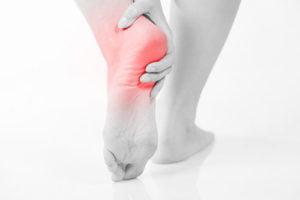Heel Pain
Disabling pain affecting the heel is one of the most common foot conditions we treat!
 Heel pain can be broken down into a number of different conditions which are treated differently.
Heel pain can be broken down into a number of different conditions which are treated differently.
A number of things can have an impact on the type of heel pain that is involved. For example, in a young person Severs, which is an inflammation of an active area of growth in the heel, is the most common cause of heel pain. For an adult, however, the most common cause is plantar fasciitis or plantar heel pain syndrome which affects approximately 7% – 12% of the population over the age of 16.
The plantar fascia is a strong band that runs underneath the foot and connects the forefoot and the heel together. It is a very strong stabilising ligament of the foot, and produces 27% of the overall rigidity of the foot. It helps to prevent elongation of the arch, but at the same time allows the foot to be able to adapt to uneven ground and be a firm spring.
Plantar fasciitis is typified in a lot of cases by pain first thing in the morning when getting out of bed or when rising from a non-weightbearing or seated position to a standing position. Heel pain or plantar fasciitis can be associated with a number of different causes, including excessive pronation or flattening of the foot and foot position, an increase in body weight or activity levels, a change in footwear or incorrect footwear, standing for prolonged periods of time at work, a repetitive micro-trauma or a combination of any of the above. It is important that the most likely cause of this condition is diagnosed and addressed correctly.
Diagnosis:
A specific diagnosis of the cause of heel pain is particularly important to establish a specific treatment regime. Sometimes imaging such as x-rays and ultrasounds can be used to identify different causes and different tissues affected in plantar heel pain. At Waikato Podiatry Clinic we use a range of different treatment options to help tailor the specific treatments to each individual’s needs and circumstance. It is not a good idea to expect a catch all treatment for this problem, as often the cause of injury and the specifics of the individual are quite different.
Heel Pain in Children
Heel pain in children differs significantly from that of adults and an individual diagnosis and treatment plan needs to be made. Gone are the days when simply telling a child not to exercise is the answer, particularly with the increasing incidence of childhood obesity. We, as parents, must ensure we are doing everything possible to encourage our kids to stay active – and when heel pain interferes with this it needs to be treated seriously and managed appropriately.
At Waikato Podiatry Clinic we can help by offering a good understanding of the condition, providing several strategies surrounding reducing symptoms, and giving you a comprehensive management plan to ensure the effects of this growth-related problem can be managed effectively. It is misleading and frankly quite wrong to say that there is nothing that can be done for this condition.

